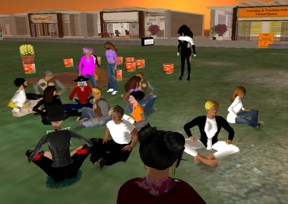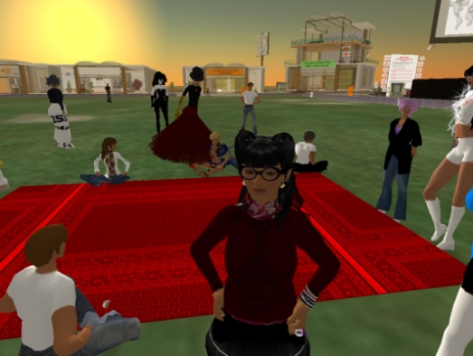Andy Powell’s live notes from the project’s final event are online here – (‘Second Life v. World of Warcraft’, Friday 13th of June 2008 at the London Knowledge Lab).
Project Updates Mar, April, May 08
June 15, 2008
Project – final event notes
Posted by socialworlds under Events, Project Updates Mar, April, May 08Leave a Comment
June 11, 2008
March 13, 2008
Notes on 2nd CMC class
Posted by socialworlds under Project Updates Mar, April, May 08Leave a Comment
Martins’ notes.
We planned this session with the experiences of the first still fresh in our minds; it was certainly different doing this for a second time. I felt more able to take control of the situation, because it felt like I knew at least some of the things I needed to watch out for.
But, first, a new outfit, because you can’t wear the same stuff all the time!
As per Diane’s other posting, we wanted to find a way that would structure the reporting back from students. We wanted to do two things: to avoid death by a thousand cuts as one student after another provided a two-minute summary of their research, because we feared this would become very repetitive and uninformative, and to try and create useful discussions, because I felt that last session was good for generating ideas but less good at developing them.
Thinking about all this, I drew on a technique that I’ve heard about for workshops (and seen used in masterclasses) called “fishbowl” – where a group does something, and then there are spectators. It struck me that the visual element of this (two sets of rules, determined by spatial location) might be much easier to apply in Second Life than in a purely textual environment. So we had a format where a group of students would discuss the issues (rather than their data per se), prompted and provoked by one tutor, with others watching; and then for a closing five minutes all those who had been waiting patiently would have a chance to interrogate those on the “inside”.
I was delighted when I turned up that Diane had created a lovely red carpet to group around – very visual and striking. The spatial locus of rules would – I thought – be immediately obvious by who was on or off of the rug. (I failed to account for the one participant who sat on the edge… there’s always a way of breaking the system!) It did provide a very helpful focal point for the event, I thought, and was much less obtrusive or divisive than (say) putting people on a stage.
The first real difficulty was that the groups we’d envisaged for the turn-taking didn’t quite work. Absences meant that some of the planned groups weren’t viable, for example. This meant re-arranging on the fly. The hard thing here was the immediacy of the situation and the lack of cues; we didn’t know from looking at people who’d done what (as we might have done from looking at postings in a discussion area), and people were waiting for guidance (whereas they might be willing to wait a day or so in a VLE). We had to private message between the three tutors to try and work out what might turn into viable groups, then one of us make an announcement about what would happen.
Once we had decided on groups and a running order, the show commenced. The discussions worked fairly well – a single tutor and about half a dozen students meant that the conversation could be managed and directed, rather than just becoming a process of free association. The size of groups was enough so that conversation flowed, but not so large that it was impossible to keep track of all the simultaneous postings. In some of the discussions, students on the rug spent a lot of time interrogating each other, which was ideal; when needed we intervened as tutors, but for the students to be taking on thoughtful, questioning roles was great to see.
Things became a bit chaotic with the closing five-minute free for all, but that was ok; by this point, pedagogic points had been made, and there was scope for people to engage in different kinds of ways. Useful questions still got asked, though – and people were very good about holding such questions until the end.
Handovers between groups worked well – there was no real issue with people swapping on and off.
The short format for the discussions kept a sense of pace to the event. It can be quite tiring to have to monitor the flow of conversation and respond immediately, so swapping between the tutors was an asset, but in addition to that the five minute free-for-all took attention away from the tutor, allowing a chance to pause, take stock and see what needed to happen next. The session felt like it went quickly, but had a lot packed into it – something I took as a positive sign. I don’t remember much time being wasted with herding avatars or giving instructions either; the format was simple enough to understand and people played along with it, allowing us to focus attention on the themes being discussed.
As before, it was useful to have more than one tutor around; we had additional interlopers this time, including one educator who turned up to see what we were doing and who tried to join in. Having a private conversation with them would have been hard to do at the same time as actually running the class, so it was good to be able to share responsibilities around such things. This incident also emphasised the way in which our teaching situation was quite different from the privacy of closed classrooms or password-protected VLEs. It felt quite different – perhaps exposed would be a good word – to be teaching ‘in public’ in this way.
March 6, 2008
The second session went well. Splitting the group (as per the plan on the earlier post) helped give the group’s discussion some order, without draining away room for improvisation, interruptions and ad-libs.
Again, having 3 of us was really valuable. We did swap these unofficial roles but to some extent Caroline positioned herself within the group and thus helped to keep the discussion rolling and on track, Martin was asking leading questions and I was doing quite a lot of herding and one-to-one (IM) queries.
Towards the end of the session there was quite a lot of positive, spontaneous feedback – that it was the best week of the course so far, and queries as to whether the next part of the course could be in Second Life as well. We’ll know more from the entries and reports that the students enter on their regular VLE (Blackboard) as it’s not very likely that those who have found it unsatisfying or anxiety provoking would say so during the class.
While the session was certainly structured, it still had almost a party atmosphere – a sense that the students were motivated and excited about virtually meeting up. This is something that came out of the interviews after our sessions last term – Andrew found that the full-time students compared SL with face-to-face situations, to SL’s detriment, whereas the part-time distance students found the simultaneity and social immediacy of SL very compelling.
We are planning a follow-up interview with Caroline (the course tutor) and to interview students.
Here’s a picture of our ‘stage’ as the students begin to arrive. The rug was just pulled out of the inventory library and then made bigger and redder using the edit menu – easy!
dc


